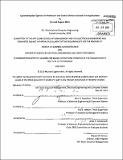Communication options for protection and control device in Smart Grid applications
Author(s)
Minh, Hyunsik Eugene
DownloadFull printable version (15.70Mb)
Other Contributors
Leaders for Global Operations Program.
Advisor
John G. Kassakian and Roy E. Welsch.
Terms of use
Metadata
Show full item recordAbstract
Increasing use of electricity, interest in renewable energy sources, and need for a more reliable power grid system are some of the many drivers for the concept of the Smart Grid technology. In order to achieve these goals, one of the critical elements is communication between systems or between the system and human beings. With the decreasing cost of various communication technologies, especially wireless devices and utilities, researchers are increasingly interested in implementing complex two-way communication infrastructures to enhance the quality of the grid. The protection and control relay at the distribution level is one of the key component in enhancing the efficiency, security and reliability of power grid. At present, it may be premature to apply wireless devices to power electronics and to distribution automation, especially for protection and control relays in the distribution level. While fiber technology is still very attractive for protection and control applications in general, wireless technology can bring improvements in user experience applications in the future. The ABB medium voltage group needs to overcome challenges that arise from conservative industry structure, increasing complexity and cost of the product, and needs for higher reliability and security. However, with collaborative efforts among different product groups, the medium voltage group will successfully develop next generation distribution feeder relay.
Description
Thesis (M.B.A.)--Massachusetts Institute of Technology, Sloan School of Management; and, (S.M.)--Massachusetts Institute of Technology, Dept. of Electrical Engineering and Computer Science; in conjunction with the Leaders for Global Operations Program at MIT, 2013. Cataloged from PDF version of thesis. Includes bibliographical references (p. 74-75).
Date issued
2013Department
Leaders for Global Operations Program at MIT; Massachusetts Institute of Technology. Department of Electrical Engineering and Computer Science; Sloan School of ManagementPublisher
Massachusetts Institute of Technology
Keywords
Electrical Engineering and Computer Science., Sloan School of Management., Leaders for Global Operations Program.